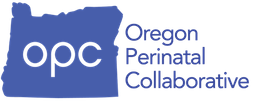Severe Hypertension in Pregnancy & Postpartum
Improving Care and Outcomes


Background
Hypertensive disorders of pregnancy are a leading cause of maternal and perinatal morbidity and mortality in the United States. 15% of births in Oregon are affected by hypertensive disorders of pregnancy. (Oregon Center for Health Statistics, 2023).
Hypertensive disorders of pregnancy increase the risk of short-term complications like seizures and stroke during pregnancy and long-term ones like cardiovascular disease after the pregnancy ends, as well as short and long-term outcomes for newborns. An Oregon Perinatal Collaborative workgroup created a TOOLKIT using the Alliance for Innovation on Maternal Health (AIM) bundle and resources from local and national stakeholder groups to support teams with implementation. This toolkit has been organized to support teams across different care settings. Information for pregnant and postpartum women and people, as well as the broader community are also included to increase awareness and develop a community of care for Oregonians.
From June 2024-June 2025, hospital teams across Oregon are participating in a quality initiative to implement the Severe Hypertension in Pregnancy and Postpartum toolkit.
The goal of the hospital initiative is to ensure timely treatment of severe hypertension and reduce severe maternal morbidity among patients with preeclampsia.
Additional stakeholders are engaged to support work outside of hospital maternity units, including clinics, the emergency department and in the community.
Additional Resources
Clicking on each tab on the left below will display the additional content and links for each section
Key readiness takeaway: Readiness requires teams in maternity/ labor and delivery units, emergency departments, the community (doulas, community midwives, home visiting RN’s, etc), and prenatal/ postpartum/ community clinics to engage and work together effectively. Consider the role you play and how to escalate to a higher level of care when needed.
- Accurate Blood Pressure Measurement (toolkit pdf) | California Maternal Quality Care Collaborative (cmqcc.org)
- POST-BIRTH Warning Signs Education Program – AWHONN
- CDC Urgent Maternal Signs
- ACOG Practice Bulletin 222, Gestational Hypertension and Preeclampsia
- CMQCC Simulation Examples
- CMQCC Professional Education Slides
- Diversity Science Dignity in Pregnancy and Childbirth
- CMQCC Example Medication Kit Acute Onset Severe Hypertension
Key recognition & prevention takeaway: Recognition and treatment requires that all teams- including those in the emergency department, clinics, community-based care (community-based midwives, community health RN’s, doulas, etc), and labor and delivery- are aware of the signs and symptoms of hypertension in pregnancy and postpartum.
- CDC/ ACOG Pregnancy Sign
- CDC Urgent Maternal Signs
- Accurate Blood Pressure Measurement (toolkit pdf) | California Maternal Quality Care Collaborative (cmqcc.org)
- Preeclampsia Foundation Cuff Kit Project
- How to take your blood pressure-Preeclampsia Foundation
- Blood Pressure Log-Preeclampsia Foundation
- Preeclampsia Foundation Signs and Symptoms
- ACOG Practice Advisory-Low Dose Aspirin Use for the Prevention of Preeclampsia and Related Morbidity and Mortality
- Ask About Aspirin (preeclampsia.org)
- 211-Community Resource Information
- Preeclampsia Foundation Patient Education Long Term Risk
- CMQCC Patient Education Checklists
Key response takeaway: Standardized tools and checklists for each care setting should be readily available/familiar to and used by all team members to support consistent response. Continued monitoring in the postpartum period is increasingly recognized as critical to identify hypertension disorders of pregnancy/postpartum—even in those who did not have any during pregnancy or delivery.
Key reporting and systems learning takeaway: Multiple measures-including outcome and process-as well as a culture of briefing/ debriefing/ case reviews support teams in reporting and systems learning.
- CMQCC Sample Debrief Form
- Placeholder AIM severe maternal morbidity review form—to be available end of summer 2024
- Perinatal Quality Improvement 2022 Webinar on improving data collection and review process by race/ethnicity
- AIM Severe Hypertension Bundle Measures
Key respectful, equitable and supportive care takeaway: Respectful and equitable care requires attention to communication (verbal and nonverbal), shared decision making and inclusion of the pregnant or postpartum person’s values and goals.
OPC Severe Hypertension Focus Group Report
- CMQCC webinar Let’s Talk Perinatal Equity Webinar and slides that also include data considerations
- IHI Achieving Health Equity: A Guide for Health Care Organizations
- AWHONN Respectful Maternity Care Toolkit
- Family to Family Support Respectful, Equitable Care Certification
- IHI Black Maternal Health: Reducing Inequities through Community Collaboration
- Trauma Informed Oregon
- Cultural Humility TEDx_Mosley
- Preeclampsia Foundation Birth Trauma Resources
- Diversity Science Dignity in Pregnancy and Childbirth
Content Last Updated: January 28, 2025
